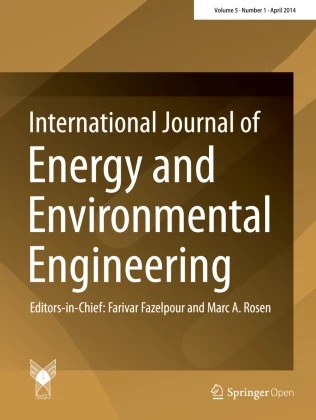A multi-objective approach for renewable distributed generator unit’s placement considering generation and load uncertainties
- Department of Electrical and Electronics Engineering, University College of Engineering Kakinada, J.N.T.U Kakinada, Kakinada, IN
- Department of Electrical and Electronics Engineering, Aditya Engineering College, Surampalem, IN

Published in Issue 2021-10-21
How to Cite
Jayaram, K., Ravindra, K., Prasad, K. R. K. V., & Murthy, K. V. S. R. (2021). A multi-objective approach for renewable distributed generator unit’s placement considering generation and load uncertainties. International Journal of Energy and Environmental Engineering, 13(3 (September 2022). https://doi.org/10.1007/s40095-021-00438-5
Abstract
Abstract Penetration of Renewable distributed generation (RDG) units has increased in recent years due to increased environmental concerns and depleting fossil fuels. Deployment of RDG units will offer technical benefits such as loss minimization, bus voltage profile improvement, line loading reduction. Optimal allocation of RDG units is a challenging task as the generation is time-varying and uncertain in nature. In this work, optimal RDG allocation problem is formulated by considering time-varying and uncertain nature of generation and load demand using a Point estimate method (PEM)-based load flow with an objective to simultaneously minimize losses, improve voltage profile and reduce line loading. An efficient pareto front-based Multi-objective Backtracking search algorithm (PMBSA) is proposed in this work to solve optimal renewable DG placement problem. Results obtained with PEM are compared with those obtained with Monte Carlo simulation method. Efficacy of formulated approach proposed in this paper is verified on a practical 67-bus distribution system and IEEE-118 bus test system. Results show that PMBSA is superior to the standard NSGA-II algorithm in obtaining near optimal solution for optimal RDG allocation problem. It is verified that proposed approach ensures very less voltage limit violations of bus voltages.Keywords
- Pareto Multi-objective Backtracking Search Algorithm (PMBSA),
- DG allocation,
- NSGA-II,
- PEM load flow,
- Monte Carlo-based load flow
References
- Adefarati and Bansal (2016) Integration of renewable distributed generators into the distribution system: a review (pp. 873-884) https://doi.org/10.1049/iet-rpg.2015.0378
- Atwa and El-Saadany (2011) Probabilistic approach for optimal allocation of wind-based distributed generation in distribution systems (pp. 79-88) https://doi.org/10.1049/iet-rpg.2009.0011
- Liu et al. (2011) Optimal siting and sizing of distributed generators in distribution systems considering uncertainties (pp. 2541-2551) https://doi.org/10.1109/TPWRD.2011.2165972
- Shaaban et al. (2013) DG allocation for benefit maximization in distribution networks (pp. 639-649) https://doi.org/10.1109/TPWRS.2012.2213309
- Evangelopoulos and Georgilakis (2014) Optimal distributed generation placement under uncertainties based on point estimate method embedded genetic algorithm (pp. 389-400) https://doi.org/10.1049/iet-gtd.2013.0442
- Hung et al. (2014) Determining PV penetration for distribution systems with time-varying load models (pp. 3048-3057) https://doi.org/10.1109/TPWRS.2014.2314133
- Kayal and Chanda (2015) Optimal mix of solar and wind distributed generations considering performance improvement of electrical distribution network (pp. 173-186) https://doi.org/10.1016/j.renene.2014.10.003
- Ameli et al. (2017) Profit-based DG planning considering environmental and operational issues: a multiobjective approach (pp. 1959-1970) https://doi.org/10.1109/JSYST.2015.2426053
- Zheng et al. (2017) Multi-objective distributed wind generation planning in an unbalanced distribution system (pp. 186-195) https://doi.org/10.17775/CSEEJPES.2017.0023
- Balaban et al. (2017) Analysing renewable energy source impacts on power system national network code (pp. 1-18)
- Sima, C.A., Lazaroiu, G.C., Dumbrava, V., Roscia, M., Zaninelli, D., and Duquenne, P.: Stochastic programming approach for TEP optimization considering RES integration in electricity market. International Conference on energy and environment (CIEM). 485–489 (2017)
- Meena et al. (2018) Improved elephant herding optimization for multiobjective DER accommodation in distribution systems (pp. 1029-1039) https://doi.org/10.1109/TII.2017.2748220
- Yarahmadi and Shakarami (2018) An analytical and probabilistic method to determine wind distributed generators penetration for distribution networks based on time-dependent loads (pp. 404-413) https://doi.org/10.1016/j.ijepes.2018.06.025
- Mirza et al. (2018) Distributed generation allocation considering uncertainties https://doi.org/10.1002/etep.2585
- HassanzadehFard and Jalilian (2018) Optimal sizing and location of renewable energy based DG units in distribution systems considering load growth (pp. 356-370) https://doi.org/10.1016/j.ijepes.2018.03.038
- Kiran Babu and Sydulu (2019) A solution to multi-objective optimal accommodation of distributed generation problem of power distribution networks: An analytical approach https://doi.org/10.1002/2050-7038.12093
- Abdelaziz and Moradzadeh (2019) Monte-Carlo simulation based multi-objective optimum allocation of renewable distributed generation using OpenCL (pp. 81-91) https://doi.org/10.1016/j.epsr.2019.01.012
- Ahmed et al. (2020) Probabilistic generation model for optimal allocation of wind DG in distribution systems with time varying load models https://doi.org/10.1016/j.segan.2020.100358
- Aliabadi and Radmehr (2021) Optimization of hybrid renewable energy system in radial distribution networks considering uncertainty using meta-heuristic crow search algorithm https://doi.org/10.1016/j.asoc.2021.107384
- Ministry of New and Renewable energy, Government of India.
- http://niwe.res.in
- . Accessed 2 Feb 2017
- Kollu et al. (2012) Mixture probability distribution functions to model wind speed distributions https://doi.org/10.1186/2251-6832-3-27
- Chun-Lien (2005) Probabilistic load-flow computation using point estimate method (pp. 1843-1851) https://doi.org/10.1109/TPWRS.2005.857921
- Civicioglu (2013) Backtracking search optimization algorithm for numerical optimization problems (pp. 8121-8144)
- Raghuwanshi, M.M., Kakde, O.G.: Survey on multiobjective evolutionary and real coded genetic algorithms. In:
- Proceedings of the 8th Asia pacific symposium on intelligent and evolutionary systems
- . 150–161 (2004)
- Deb et al. (2002) A fast and elitist multiobjective genetic algorithm: NSGA-II (pp. 182-197) https://doi.org/10.1109/4235.996017
- Patibandla et al. (2021) A multi-objective approach for the optimal design of a standalone hybrid renewable energy system https://doi.org/10.1002/er.6957
- Nekooei et al. (2013) An improved multi-objective harmony search for optimal placement of DGs in distribution systems (pp. 557-567) https://doi.org/10.1109/TSG.2012.2237420
- Zitzler et al. (2000) Comparison of multiobjective evolutionary algorithms: empirical results (pp. 173-195) https://doi.org/10.1162/106365600568202
- Ravindra, K., Jayaram, K.: Multi-Objective approach for capacitor placement considering uncertainty using point estimate method. IEEE Region 10 Symposium (2017).
- https://doi.org/10.1109/TENCONSpring.2017.8070098
- Kollu et al. (2014) A novel method for optimal placement of distributed generation in distribution systems using HSDO (pp. 547-561) https://doi.org/10.1002/etep.1710
- Ghasemi and Moshtagh (2013) Radial distribution systems reconfiguration considering power losses cost and damage cost due to power supply interruption of consumers (pp. 297-315)

 10.1007/s40095-021-00438-5
10.1007/s40095-021-00438-5











